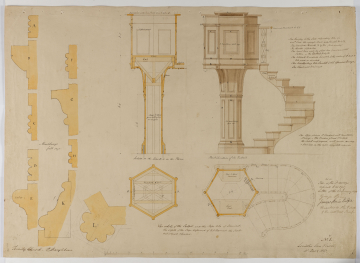Scale
bar scale of 1 inch to 1 foot
Inscribed
Trinity Church_ St. Marylebone. / No.1 . / 2 / A B C D E / F G H / Mouldings / full size. / I J K L / The whole of the Pulpit, and the Steps to be of Wainscot. / the Soffite of the steps to be formed of ¾ (inch?) Wainscot, the Joints / crop tongued & beaded.. / O / nosing. / 5 ½” by 2 ½” dovetailed at angles & / to end of joints. / Deal Joists 5” by 2” / S / O / Seat. / Deal. / Desk 1 ¼” thick / Wainscot / Door. / to be hung with proper / brass hinges & m[ounted] [?] / latch / S / Pannel / Pannel / Landing. / This is / one of / the Drawings referred to in our / Letter of the 20 January 1820 (?) / George Bird / James Bainbridge / Executors to the Estate / of the late Danl. Sharp Section on the Line O. S. in the Plans / Shaft 1 ½” thick / glued & blocked / at angles / ¾ [_ _ _] / ¾ Wainscot / / Deal. /1 ¼ W. / Landing / 1 ¼” deal. . 5”. x 2” Deal / bd. Flush pannel. // Ledge faced with Iron Studs so as to take off. / Back Elevation of the Pulpit./ K / See mouldings / full size. / H / H / G / F F / E E / D / D / L L / See mouldings full size. / C C / B / A / Desk. / Wainscot Handrail 2 ½” by 2” / 11/2 Wainst / to project 3/8 from the stairs / / E. / E. / The Railing to the steps & Landing to be of / Wsct. Iron. The upright Rails and Pannels ¾ by 3/8. / The Diamond Pannels ¼ by 5/8- (14 in number) / The Rosettes of Cast Iron. / The newel Bars will be of Cast iron of an Ornamneted / Pattern:_the Top Rail, ¾ by 3/8 / The Estimate to include Ironwork to the value of £3. 0. 0 / to be used as directed. / The Iron Railing to be Painted [R]ails & finished Bronze. / The Handrail Wainscot. / The steps & risers 1 ¼ Wainscot with moulded / Nosings _ the Windows glued & blocked / the Joints crop tongued with proper carriage / & finished in the most complete manner.
Signed and dated
- 10 December 1827
Lincolns Inn Fields / 10th. Decr. 1827
Medium and dimensions
Pencil, pen, coloured washes of blue, brown and yellow, pricked for transfer on wove paper (730 x 523)
Hand
Probably Bailey, George (1792--1860), draughtsman
Watermark
SMITH&ALLNUTT / 1823
Level
Drawing
Sir John Soane's collection includes some 30,000 architectural,
design and topographical drawings which is a very important resource for
scholars worldwide. His was the first architect’s collection to attempt to
preserve the best in design for the architectural profession in the future, and
it did so by assembling as exemplars surviving drawings by great Renaissance
masters and by the leading architects in Britain in the 17th and 18th centuries
and his near contemporaries such as Sir William Chambers, Robert Adam and
George Dance the Younger. These drawings sit side by side with 9,000 drawings
in Soane’s own hand or those of the pupils in his office, covering his early
work as a student, his time in Italy and the drawings produced in the course of
his architectural practice from 1780 until the 1830s.
Browse (via the vertical menu to the left) and search results for Drawings include a mixture of
Concise catalogue records – drawn from an outline list of the collection – and
fuller records where drawings have been catalogued in more detail (an ongoing
process).


